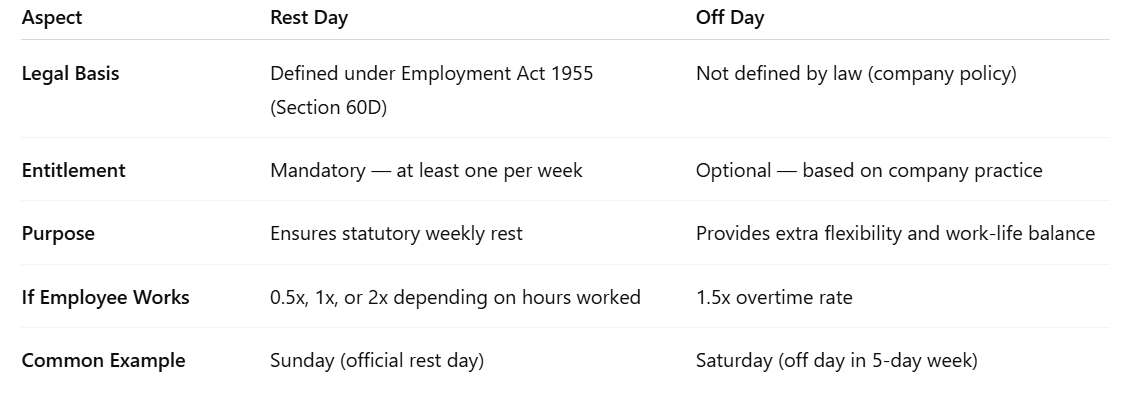
In many Malaysian workplaces, the terms “off day” and “rest day” are often used interchangeably — but under the Employment Act 1955, they carry very different meanings.
For HR and payroll teams, understanding this difference is not just good practice — it’s essential for accurate payroll calculation, compliance with labour law, and maintaining fair treatment of employees.
Why Employers Must Know the Difference
Misclassifying an employee’s off day as a rest day (or vice versa) can lead to:
-
Payroll non-compliance, especially in overtime or rest day pay.
-
Employee grievances or labour disputes over underpayment.
-
Penalties or back-pay orders under the Employment Act 1955.
In short, the distinction directly affects your company’s legal compliance and payroll accuracy.
What Is a Rest Day in Malaysia?
Under Section 60D of the Employment Act 1955, every employee must receive at least one rest day per week.
Usually, this is Sunday, but it can be any day as determined by the employer, depending on operational needs. The designated rest day must be clearly stated in the employment contract or work schedule.
During the rest day:
-
Employees cannot be required to work, except under limited conditions such as emergencies or essential services.
-
If they do work, employers must follow the prescribed rest day pay rate below:

What Is an Off Day in Malaysia?
An off day is not defined by law — it’s a company-granted non-working day provided in addition to the mandatory rest day.
For example, in a 5-day work week, employees may have Saturday and Sunday off, but only one (usually Sunday) is the official rest day under the law.
The other (Saturday) is considered an off day, based on company policy or work arrangement.
When employees work on an off day, it’s treated as normal overtime, paid at 1.5x the hourly rate.

Key Differences Between Rest Day and Off Day

Why This Matters for HR and Payroll
Getting this distinction right helps your company:
-
Ensure accurate overtime and rest day pay.
-
Maintain compliance with Section 60D of the Employment Act.
-
Build trust and transparency with employees.
-
Avoid labour disputes and costly back-pay claims.
Example in Practice
In some real-world labour cases, employers labelled off days as rest days to pay only 1.5x instead of the legal 2x rate. The Labour Department later ordered back-pay corrections and penalties for violating the Act.
This highlights the importance of accurate classification and clear documentation in payroll systems.
Best Practices for Employers
To stay compliant and avoid disputes:
-
Clearly define the rest day in each employee’s contract.
-
Apply correct pay rates when employees work on rest days vs off days.
-
Use an HR system (like Pandahrms) to automate and reflect rest day entitlements accurately.
-
Keep complete attendance and overtime records.
-
Train HR and payroll staff on the legal difference between the two.
FAQs
1. Can an employer change an employee’s rest day?
Yes. However, any change must be communicated in advance and recorded in the company’s official schedule. Employees must still receive one full rest day each week.
2. What happens if a public holiday falls on a rest day?
If a public holiday coincides with a rest day, the employee is entitled to a replacement holiday on another day, according to Section 60D(1)(b).
3. How should overtime be calculated?
-
On a rest day: 0.5x, 1x, or 2x depending on hours worked.
-
On an off day: 1.5x (normal overtime rate).
Simplify Payroll Compliance with Pandahrms
Managing multiple schedules, off days, and rest day pay can be complex — especially for growing teams.
With Pandahrms, your HR and payroll processes are automated, accurate, and fully compliant with Malaysian labour laws. From leave and attendance tracking to rest day pay calculations, everything is handled in one seamless platform.




